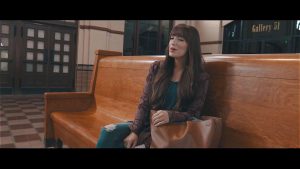 Dahlia Row has returned with another awe-inspiring, heartfelt song. This time they are performing the beautiful love song, “La Vie en rose,” which was the signature song of French singer Édith Piaf. Although the song was written in 1945, popularized in 1946, and released as a single in 1947, Dahlia Row, with their unique musical style, presents the song as a modern-day love story. One person is waiting at the train station for the announcement to board the train that will take her to her destination, all the while thinking about her one true love. Another person also waits in another part of the station to board a train, and even sends a text message to his true love, “Just waiting for the train. Missing you already.”
Dahlia Row has returned with another awe-inspiring, heartfelt song. This time they are performing the beautiful love song, “La Vie en rose,” which was the signature song of French singer Édith Piaf. Although the song was written in 1945, popularized in 1946, and released as a single in 1947, Dahlia Row, with their unique musical style, presents the song as a modern-day love story. One person is waiting at the train station for the announcement to board the train that will take her to her destination, all the while thinking about her one true love. Another person also waits in another part of the station to board a train, and even sends a text message to his true love, “Just waiting for the train. Missing you already.”
 The song was originally sung in the beautiful French language and the literal translation of the song title is “Life in Pink” but can be translated as “Life in Rosy Hues” or “Life through Rose-colored glasses.” The eloquent violin playing combined with the rich vocals in French and in English create a nostalgic atmosphere that almost makes a person feel that they have stepped back in time to 1947 and are listening to the song as it played over the airwaves for the first time.
The song was originally sung in the beautiful French language and the literal translation of the song title is “Life in Pink” but can be translated as “Life in Rosy Hues” or “Life through Rose-colored glasses.” The eloquent violin playing combined with the rich vocals in French and in English create a nostalgic atmosphere that almost makes a person feel that they have stepped back in time to 1947 and are listening to the song as it played over the airwaves for the first time.
Keeping to the true meaning of the song, the story of two people in love continues as the singers sing about their one true love as if nothing else matters because they are viewing the world through rose-colored glasses. The words to the second verse of the French version of the song expresses how two people in love can easily shut out the world around them:
Quand il me prend dans ses bras – When he takes me in his arms
Il me parle tout bas – He whispers to me
Je vois la vie en rose – I see life in pink
Il me dit des mots d’amour – He tells me love words
Des mots de tous les jours – Everyday words
Et ça me fait quelque chose – And it does something to me.
In 1950, the song “La Vie en rose,” became popular in the United States with no fewer than seven different versions reaching the Billboard charts. The seven versions were sung by Tony Martin, Paul Weston, Bing Crosby, Ralph Flanagan, Victor Young and Louis Armstrong. Although the song is a love ballad – the story of two young lovers – the song became a success partly due to the lyrics, which in the wake of World War II, spoke directly to the hearts of those who had suffered from the war.


